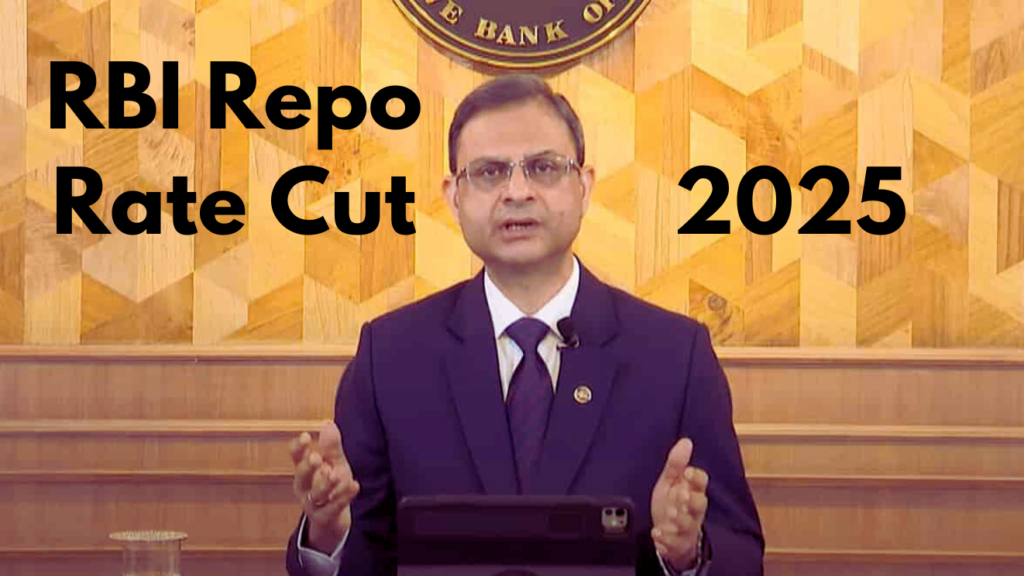RBI Governor Announces Surprise Repo Rate Cut
In a surprising turn of events, the Reserve Bank of India (RBI) has announced a 25 basis point cut in the repo rate, bringing it down to 6.25%. This marks the first rate cut in nearly five years, signaling a potential shift in the central bank’s monetary policy.
RBI Governor Sanjay Malhotra, in his official statement, emphasized that the decision was taken unanimously by the Monetary Policy Committee (MPC) after careful evaluation of current economic conditions. The move is expected to lower borrowing costs, spur investment, and boost economic activity.

What is the Repo Rate and Why Does It Matter?
The repo rate is the interest rate at which RBI lends money to commercial banks. A lower repo rate makes borrowing cheaper for banks, encouraging them to extend more credit to businesses and consumers. This can lead to increased investment, higher consumer spending, and overall economic growth.
Why Did RBI Cut the Repo Rate?
Several factors likely influenced the RBI’s decision to cut the repo rate:
- Slowing Economic Growth – India’s GDP growth is projected at 6.4% for FY25, the slowest in four years. The rate cut is aimed at boosting investment and consumption.
- Declining Inflation – Retail inflation has been easing, reaching 5.22% in December 2024, bringing it closer to the RBI’s 4% target.
- Global Uncertainties – Geopolitical tensions, fluctuating commodity prices, and global economic slowdowns have impacted India’s growth outlook.
Impact of the Rate Cut on the Economy
This unexpected decision is set to have far-reaching consequences across various sectors:
1. Home Loans and Consumer Borrowing
Lower interest rates mean that home loans, car loans, and personal loans will become more affordable. This could boost demand in the housing and automobile sectors.
2. Business Investments
With cheaper credit, businesses can expand operations, invest in new projects, and create more jobs, ultimately driving economic growth.
3. Stock Market Reactions
Rate cuts often lead to positive sentiment in stock markets. Investors expect better corporate earnings due to lower borrowing costs. Sectors like banking, real estate, and automobiles could see an uptick.
Risks and Challenges
While the rate cut brings several benefits, it also carries some potential risks:
- Inflation Concerns – If demand rises too quickly, inflationary pressures could resurface, forcing the RBI to reverse its stance.
- Banking Liquidity – Some experts argue that a rate cut alone won’t boost lending unless there’s adequate liquidity in the banking system.
What’s Next for RBI’s Monetary Policy?
Governor Malhotra reassured that the RBI remains committed to balancing economic growth and price stability. The central bank will closely monitor inflation trends and adjust policies accordingly.
This rate cut marks a significant policy shift and could be the start of a new phase in India’s monetary strategy. Whether the RBI will continue easing rates in the coming months depends on economic data and inflation trends.
Final analysis
The RBI’s first repo rate cut in five years is a major development for India’s economy. It offers relief for borrowers, supports businesses, and aims to reignite growth. However, its success will depend on how effectively it translates into increased credit flow and economic expansion.
What do you think about this move? Will it help revive India’s economy? Share your thoughts in the comments below!
Sources:
- India cuts rates for first time in 5 years to combat slowing growth – Financial Times
- India’s central bank cuts repo rate for first time in nearly 5 years – Reuters
- India cuts rates for first time in nearly 5 years to boost growth – Reuters
HUL Q3 FY2025 Results: Revenue, Profit, and Segment Analysis
Exciting Update: Gemini in Google Sheets Gets Enhanced Data Analysis and Visualisation Tools














